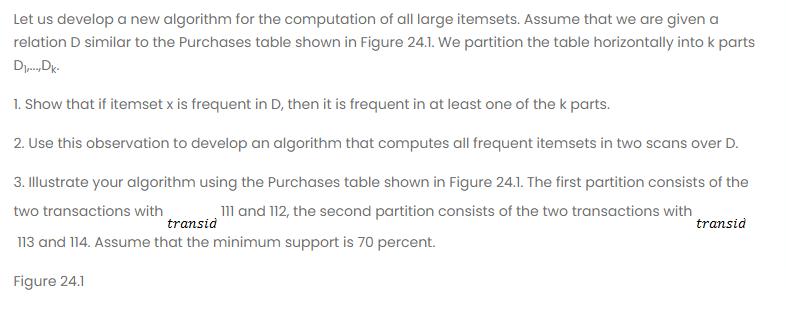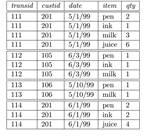Answered step by step
Verified Expert Solution
Question
1 Approved Answer
Let us develop a new algorithm for the computation of all large itemsets. Assume that we are given a relation D similar to the


Let us develop a new algorithm for the computation of all large itemsets. Assume that we are given a relation D similar to the Purchases table shown in Figure 24.1. We partition the table horizontally into k parts D... Dk. 1. Show that if itemset x is frequent in D, then it is frequent in at least one of the k parts. 2. Use this observation to develop an algorithm that computes all frequent itemsets in two scans over D. 3. Illustrate your algorithm using the Purchases table shown in Figure 24.1. The first partition consists of the two transactions with 111 and 112, the second partition consists of the two transactions with transid 113 and 114. Assume that the minimum support is 70 percent. Figure 24.1 transid fransid custid 111 201 111 201 201 1113 111 201 112 106 112 105 112 106 113 106 113 106 114 201 114 201 114 201 date item 5/1/99 pen 2 5/1/99 ink 1 milk 3 3/1/90 5/1/99 juice 6 f 6/3/99 pess 6/3/99 ink 1 6/3/99 milk 1 5/10/99 5/10/99 6/1/90 6/1/90 6/1/99 juice L pes 1 milk 1 pe ink 2 2 4
Step by Step Solution
★★★★★
3.43 Rating (159 Votes )
There are 3 Steps involved in it
Step: 1

Get Instant Access to Expert-Tailored Solutions
See step-by-step solutions with expert insights and AI powered tools for academic success
Step: 2

Step: 3

Ace Your Homework with AI
Get the answers you need in no time with our AI-driven, step-by-step assistance
Get Started


